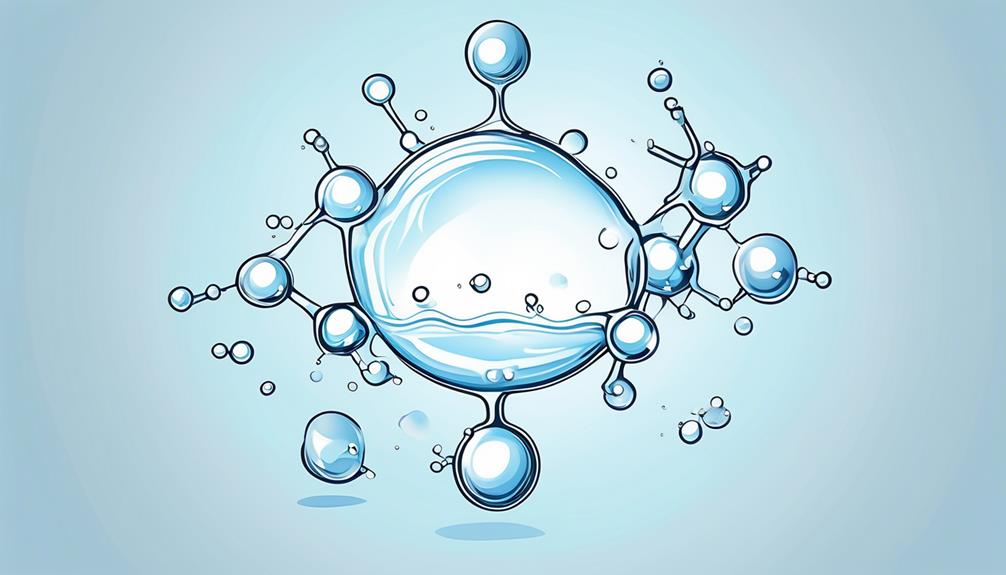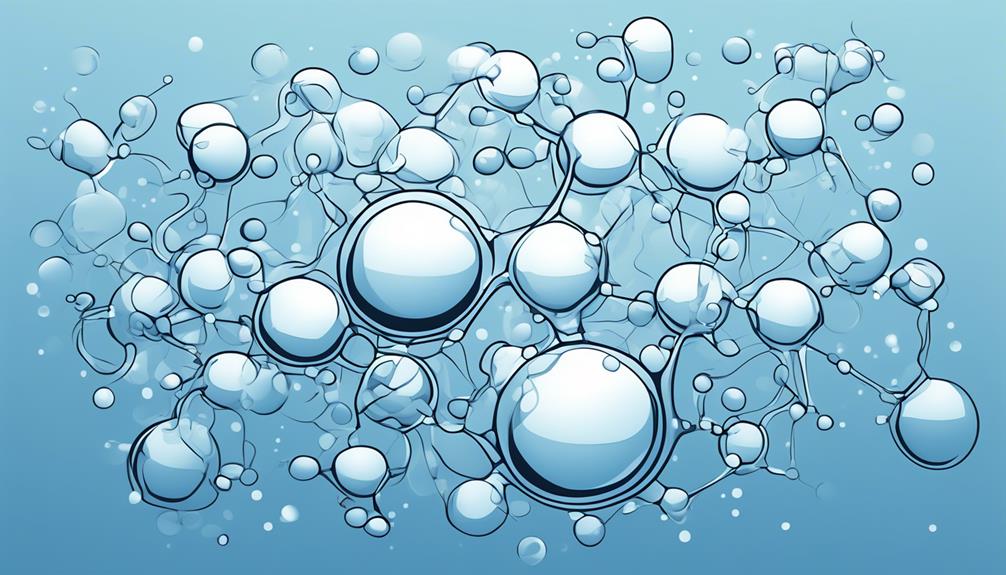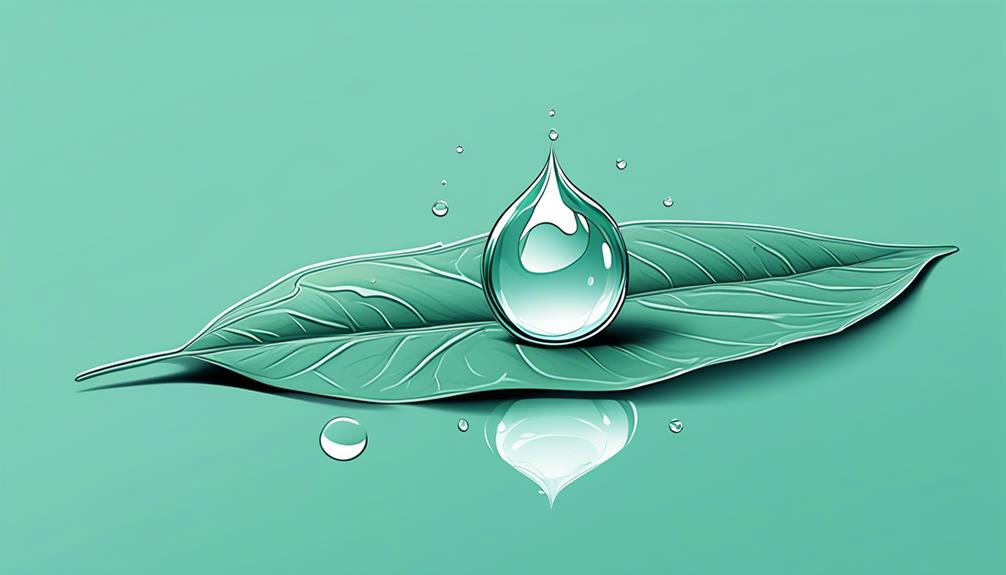Ever wondered why a tiny insect can effortlessly glide on the surface of water? The secret lies in the remarkable surface tension of water, a property that defies gravity and holds many mysteries.
Hydrogen bonds, those invisible forces between water molecules, are the superheroes behind this phenomenon. Picture a web of interconnected water molecules tightly gripping each other at the surface, creating a force field that seems to challenge the laws of nature.
But why does water exhibit such a captivating display of cohesion? Stay tuned to uncover the captivating chemistry that makes water's surface tension stand out in the realm of liquids.
Key Takeaways
- Hydrogen bonds between water molecules create high surface tension.
- Cohesive forces in water lead to water droplets beading up and small insects gliding on its surface.
- Adhesive forces allow water to stick to surfaces and play a crucial role in capillary action in plants and living organisms.
- Temperature affects water's surface tension, with higher temperatures decreasing it and lower temperatures increasing it.
Chemistry of Water Molecules
Dive into the chemistry of water molecules to uncover the secrets behind their unique properties and behavior. Water molecules, with oxygen's slightly negative charge and hydrogen's slightly positive charge, form hydrogen bonds between them. These hydrogen bonds are like tiny magnets holding the water molecules together, resisting any attempt to stretch or break the water surface. This resistance is what gives water its high surface tension, making it stick to itself more than to the air around it.
Imagine water molecules holding hands tightly across the surface, creating a strong, invisible film. This film is why water droplets bead up on surfaces and why small insects can walk on water without sinking. This cohesive force is all thanks to those hydrogen bonds.
It's these same bonds that give water its extraordinary properties, like the ability to reach maximum density at 4C, before expanding and becoming ice. And let's not forget how these bonds play a role in water having the highest surface tension of all liquids. Fascinating, right?
Hydrogen Bonding in Water
With a dipolar nature, water molecules form hydrogen bonds due to the attraction between oxygen's negative charge and hydrogen's positive charge. These hydrogen bonds are essential for the unique properties of water:
- Cohesion: Hydrogen bonds allow water molecules to stick together, creating surface tension. This cohesion is why water forms droplets and allows small insects like pond skaters to glide on its surface.
- High Heat of Vaporization: The strong hydrogen bonds in water require a significant amount of heat to break, leading to a high heat of vaporization. This property helps regulate Earth's temperature and is crucial for life.
- Physical Properties: Hydrogen bonding influences water's boiling and freezing points, which are higher than expected for a molecule of its size. These properties are fundamental for the environment and various industrial processes.
Understanding the role of hydrogen bonding in water sheds light on why water exhibits such remarkable traits, making it a cornerstone of life on our planet.
Cohesive Forces in Water
Alright, let's talk about cohesive forces in water.
Imagine water molecules holding hands tightly, creating strong bonds.
These bonds make water stick to itself more than it does to air, causing intriguing behaviors like high surface tension.
Water Molecule Structure
Water molecules, with their dipolar nature and hydrogen bonding, exhibit cohesive forces that play a crucial role in defining the high surface tension of water.
- Dipolar Nature: The oxygen atom in a water molecule attracts electrons more strongly than hydrogen, creating a slight negative charge near the oxygen and a slight positive charge near the hydrogen.
- Hydrogen Bonding: These slight charges lead to the formation of hydrogen bonds between water molecules, enhancing their cohesion.
- Strong Intermolecular Forces: The strong hydrogen bonding in water results in high surface tension, where molecules at the surface are pulled inward, resisting external forces and forming droplets, as seen in raindrops or dew on leaves.
Hydrogen Bonding Explanation
Having a dipolar nature, water molecules form hydrogen bonds that contribute to their high surface tension, defining their cohesive forces.
The oxygen end of a water molecule carries a slightly negative charge, while the hydrogen end bears a slightly positive charge. This polarity allows water molecules to attract each other through hydrogen bonding.
These bonds create a strong network that resists external forces, making water molecules more attracted to each other than to the air above. The cohesive forces generated by hydrogen bonds give water its unique properties, such as high surface tension, which supports small organisms like pond skaters.
Understanding how hydrogen bonds work in water helps explain its boiling point of 100°C, freezing point of 0°C, and high heat of vaporization of 41 kJ/mol.
Impact on Properties
With the strong cohesive forces created by hydrogen bonds in water, its properties exhibit remarkable characteristics that impact various natural phenomena and support diverse organisms. The high surface tension of water, a result of these cohesive forces, influences several aspects:
- Surface Tension: Water's high surface tension allows insects like pond skaters to walk on water due to the resistance offered by hydrogen bonds.
- Properties: The cohesive nature of water molecules affects its behavior, such as the formation of droplets and the ability to stick to surfaces.
- Water Freezes: The unique properties of water, including high surface tension, play a role in how water freezes and expands, influencing aquatic ecosystems and life forms within them.
Adhesive Forces in Water

Ever noticed how surfaces seem to attract and hold onto moisture effortlessly, creating a delicate film that defies gravity? These phenomena are a result of adhesive forces in water. Water molecules exhibit a strong attraction to other substances, leading to adhesive forces that allow water to stick to various surfaces. This adhesive property is crucial in understanding surface tension, where water forms a sort of 'skin' on its surface due to the cohesive and adhesive forces between water molecules and the surface.
Moreover, adhesive forces in water play a significant role in capillary action, enabling water to move up narrow tubes, such as in plants, by adhering to the tube's surface. This interaction is vital for processes like transpiration in plants and the functioning of capillary action in living organisms. In practical terms, adhesive forces in water also have real-world applications, such as in the effectiveness of adhesives and the ability of water to wet surfaces. Understanding these adhesive forces provides insights into various natural phenomena and technological advancements.
Role of Polarity in Surface Tension
Imagine water molecules as tiny magnets, with positive and negative ends attracting each other. This polarity creates strong cohesion through hydrogen bonds, making the surface tension high.
Picture these bonds like a tightrope walker holding hands with other walkers, resisting any force trying to pull them apart.
Polarity and Cohesion
The dipolar nature of water molecules, with oxygen carrying a slight negative charge and hydrogen a slight positive charge, plays a crucial role in creating high surface tension through the formation of hydrogen bonds. Here's why this is important:
- Attraction: The polar nature of water molecules leads to the formation of hydrogen bonds, causing water molecules to be attracted to each other.
- Resistance: These hydrogen bonds create resistance, making it difficult to stretch or break the water surface, thus increasing surface tension.
- Cohesion: The polarity and resulting hydrogen bonds make water molecules stick together, creating a strong cohesive force that keeps the molecules united and contributes to the high surface tension observed in water.
Hydrogen Bonding Effects
Moving from the discussion on polarity and cohesion, the pivotal role of hydrogen bonding in surface tension becomes evident in water's unique characteristics.
The hydrogen bonding effects between water molecules create a strong cohesive force at the surface, resisting stretching or breaking. This resistance to disruption forms a 'skin' on the water's surface, resulting in high surface tension.
Imagine each water molecule holding hands with its neighbors through hydrogen bonds, creating a tight-knit network that keeps the molecules together. These bonds make it difficult for external forces to penetrate the surface, explaining why water beads up and forms droplets.
This phenomenon not only affects everyday experiences like water droplets on a leaf but also supports life by providing habitats for various organisms.
Interactions at the Water-Air Interface

At the water-air interface, observe the fascinating dance of water molecules interacting with the surrounding air, creating a dynamic boundary full of hidden wonders.
- Surface Tension: Witness the water molecules at the surface clinging tightly together, thanks to the cohesive forces of hydrogen bonds. This phenomenon creates a thin film on the water's surface, giving it the ability to support small insects like pond skaters effortlessly.
- Interactions: Marvel at how water molecules near the interface interact differently with air compared to those in the bulk of the liquid. The molecules at the surface experience an unbalanced force, causing them to be drawn back into the water, showcasing the strong intermolecular forces at play.
- Impact: Explore how these interactions impact various aspects of life, from the high heat of vaporization of water to the unique properties of ice floating on liquid water, all stemming from the intricate dance of water molecules at the water-air interface.
Effects of Temperature on Surface Tension
With increasing temperature, water's surface tension undergoes a noticeable decrease. As the temperature rises, the water molecules gain kinetic energy, causing them to move faster and disrupt the cohesive forces responsible for surface tension. This disruption reduces the attractive forces between the molecules, leading to a weakening of the surface tension. Conversely, at lower temperatures, the hydrogen bonding between water molecules increases, resulting in stronger cohesive forces and higher surface tension.
Understanding the effects of temperature on surface tension is crucial in various natural processes and industrial applications. For instance, in biological systems, changes in temperature can impact the ability of small organisms to move on the water's surface. In industrial settings, knowledge of how temperature affects surface tension is essential for processes like inkjet printing and painting, where precise control of surface tension is required for optimal results. By grasping the relationship between temperature and surface tension, scientists and engineers can better manipulate these properties to suit specific needs.
Applications of Water's Surface Tension

Water's high surface tension presents a myriad of practical applications across various fields and industries.
- Biological Adaptations: Certain organisms like pond skaters utilize water's surface tension to stay afloat and move effortlessly on the water's surface. This unique property enables them to thrive in their natural habitats.
- Safety Measures: Water's high surface tension has real-world implications for safety, such as how it affects burns and freezing. Understanding this property can help in creating safety protocols and preventive measures in various scenarios.
- Environmental Significance: The high surface tension of water plays a crucial role in maintaining certain habitats and ecosystems. It influences the behavior of various species and contributes to the overall balance of these environments. By comprehending water's surface tension, researchers can better understand the intricacies of these ecosystems and potentially develop conservation strategies to protect them.
Frequently Asked Questions
Why Is Water Surface Tension so High?
Water's surface tension is high due to strong hydrogen bonds between molecules. They resist separation, causing cohesion. This makes water more attracted to itself than to air. The unique properties of water impact ecosystems and activities.
Why Water Has Relatively High Surface Tension?
Water has relatively high surface tension because of its hydrogen bonding. These bonds resist stretching, creating cohesion. They make water cling together, like friends in a group hug, giving it unique properties vital for life.
Why Does Water Have Maximum Surface Tension?
Water has maximum surface tension because of hydrogen bonds resisting stretching. This cohesion keeps water molecules close, forming a strong surface layer. It's like a net holding water together. This feature supports unique habitats and activities.
Why Does Water Have High Surface Tension but Low Viscosity?
Water has high surface tension due to strong hydrogen bonds between molecules, causing cohesion. Low viscosity results from molecules sliding past each other easily. This balance allows water to form droplets, support life, and exhibit unique properties.
Conclusion
So, water's surface tension is like a superhero cape, holding water molecules together with mighty hydrogen bonds. Imagine tiny water droplets forming a shield, protecting pond skaters from sinking.
The polarity of water molecules creates a strong bond, like a magnet pulling them together. Even at the water-air interface, this tension is like a force field, keeping things afloat.
It's like water is a magical liquid, creating a world where even the tiniest creatures can walk on water!
